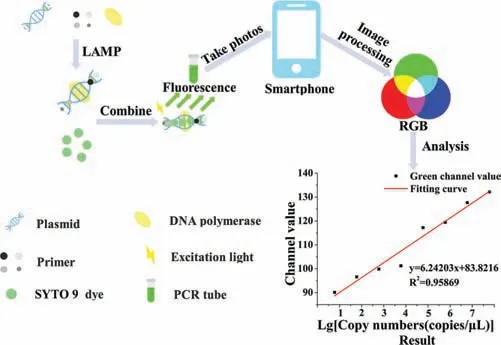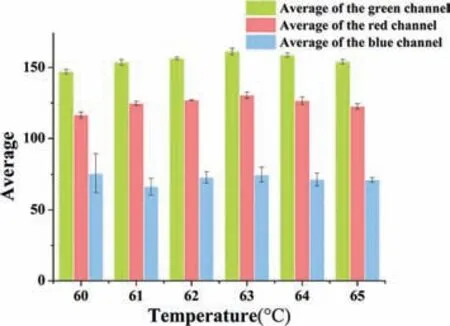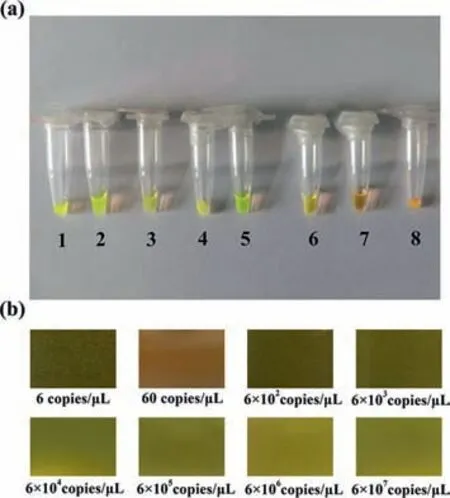Highly sensitive smartphone-based detection of Listeria monocytogenes using SYTO9
Sh Liu,Xuling He,To Zhng,Kixun Zho,Chnghu Xio,Zengrui Tong,Lin Jin,Nongyue He,d,Yn Deng,e,Song Li,e,Yun Guo,Zhu Chen,e,*
a Hunan Key Laboratory of Biomedical Nanomaterials and Devices,Hunan University of Technology,Zhuzhou 412007,China
b Department of General Surgery,People’s Hospital of Zhuzhou City Affiliated to Changsha Medical College,Zhuzhou 412011,China
c Department of Laboratory,Central Hospital of Zhuzhou City,Zhuzhou 412007,China
d State Key Laboratory of Bioelectronics,School of Biological and Medical Engineering,Southeast University,Nanjing 210096,China
e National &Local Joint Engineering Research Center for Research and Technology of Advanced Packaging Materials,Zhuzhou 412007,China
1 These authors contributed equally to this work.
ABSTRACT Listeriosis is caused by Listeria monocytogenes(LM)and is currently considered to be one of the leading food-borne diseases worldwide,with mortality rate of 20%~30%.Currently,detection methods for LM are time-consuming with low sensitivity,and delayed detection results.SYTO9 has a high affinity for DNA and exhibits enhanced fluorescence upon binding.Therefore,this study used SYTO9 staining and image processing to develop a rapid loop mediated isothermal amplification(LAMP)detection method for LM.Smartphone was successfully used for detecting the color change in different concentrations of LM.Besides,the optimized LAMP reaction temperature was 63 °C by color identification,and the limit of detection for LM was 6 copies/μL in the green channel.So,the developed method,based on image processing,is simple,sensitive and rapid,which provides a new idea and method for rapid detection of LM and other food-borne bacterial pathogens.
Keywords:Literia monocytogenes Image process SYTO9 Loop mediated isothermal amplification Smartphone
Listeria monocytogenes(LM)is one of the most lethal food borne pathogens in human and animal society[1,2].It is ubiquitous in the environment[3,4],and it can be found in most foods,such as meat products,milk,cheese,ice cream and vegetables[5–7].It can survive and grow in various polar environments of food processing,such as high salt,drying and refrigeration[8–10].The susceptible persons are adults over 40 years old,immunodeficiency individuals,pregnant women and infants[11–13].The mortality rate is as high as 20%–30%[14,15].When people and animals are infected,it will lead to meningitis,sepsis,endocarditis,abscess and local purulent damage,resulting in abortion,stillbirth and other diseases[16–18].It has been reported that the mortality rate can reach 75%,and it is one of the four major foodborne pathogens in the world[19].With irreversible trend of population aging in China,LM is a serious threat to our people’s health.Therefore,research on rapid and sensitive detection of LM is of great significance in the field of food safety.
The detection technology for LM is mainly divided into three categories:traditional detection methods,immune detection methods and molecular biologic detection methods[20–22].The traditional detection method is the traditional culture method for LM in food.Although the requirements for equipment are not high,the operation is easy,and results are accurate and reliable,the whole detection process takes 5–7 days,and consumes a lot of manpower and material resources,which cannot meet the requirements for rapid detection in modern society(online detection in the process of food production and food listed)[23].The immune detection method is based on distinguishing bacteria according to specific antigen-antibody reaction[24].It has the advantages of simple operation;fast speed and it is also easy to judge the result.However,the detection sensitivity is low and false negative results are easy to appear,which is not suitable for detection of micro LM[25].The molecular biologic detection methods include nucleic acid probe hybridization,polymerase chain reaction(PCR),nuclear acid sequence-based amplification(NASBA),multiplex PCR(mPCR),quantitative real-time PCR,loop mediated isothermal amplification(LAMP),etc.[26,27].However,the above molecular biology methods are complex in operation,take long time and high cost.LAMP has high amplification efficiency,and can achieve 109~1010times amplification in 15~60 min,which has advantages of being fast,simple,with high specificity and sensitivity[28,29].Therefore,LAMP method was selected for amplification in this study.
At present,there are many platforms for detecting the products of LAMP,such as colorimetry,turbidimetry,gel electrophoresis and fluorimetry[30–32].The detection principle for gel electrophoresis is that DNA molecules migrate under the action of electric field.Although gel electrophoresis is highly specific,it is complex,time-consuming and energy consuming,and it is also not quantitative.The detection principle for colorimetry is to observe the color change of reagent solution[33].The operation is simple and can be observed by naked eye.However,it is influenced by subjective factors.The detection principle for turbidimetry method is to observe the formation of pyrophosphatase precipitation.Although it has low cost and simple operation,it has low sensitivity.Fluorescence method can be used for quantitative detection,but the structure of equipment and instrument is complex and the cost is high.Therefore,we developed an image method based on SYTO9 to detect the products of LAMP.SYTO9 is a fluorescent nucleic acid stain that is widely used in microbiology,particularly for fluorescence microscopy and flow cytometry analyzers[34].SYTO9 can be used for detection of LAMP products that can change color[35].We then used the mobile phone to take photos about the color change after reaction[36].Python is a high-level interpreted programming language,which is widely recognized for being easy to learn,yet still able to harness the power of systems-level programming languages when necessary[37].Finally,the images were processed by the designed program based on Python.The results can be obtained immediately through image processing,saving the waiting time.The results can also be used for semi-quantitative analysis of LM,which provides a new detection idea for the laboratory.The chief flowchart of this experiment is shown in Fig.1.The materials used above are shown in Support information.

Fig.1.The flowchart of rapid detection of LM by loop mediated isothermal amplification based on image method.LAMP:loop mediated isothermal amplification.PCR:polymerase chain reaction.RGB:red,green,and blue.
To evaluate the feasibility of this approach,positive and negative controls were made.The results are shown in Fig.S1(Supporting information).Results showed a significant change in the color,with color of negative control being orange and the positive control being green.Therefore,it was possible to analyze color changes by establishing image processing.The specific implementation method of image processing was shown in the supporting information.The results from the above images were analyzed by the program based on Python(Table S1 in Supporting information).Therefore,by comparing the values of red,green and blue channels,it was found that the values of three channels of positive control all increased to a certain extent,among which the green channel was most obvious and blue channel was least obvious.The above results showed that green channel values and red channel values could be selected for further analysis in the following experiments.

Fig.2.The plasmids of LM were amplified by LAMP at different temperatures,and the optimal reaction temperature was selected.

Fig.3.The sensitivity of the method was analyzed.(a)Color changes at different copy numbers.(b)The images of a color change with different copy numbers taken by the smartphone.
In this paper,color recognition was carried out through image processing,and LAMP reaction temperature was further optimized.LAMP reaction was performed at the six temperatures(60 °C,61°C,62 °C,63 °C,64 °C,and 65 °C).Fig.2 shows the results of three channel values obtained through image processing after repeated experiments at the above six temperatures(Table S2 in Supporting information).As can be seen from Fig.2,when the temperature was 63 °C,the average values of red channel and green channel reached maximum values,which were 161.3327 and 130.5381 respectively.Therefore,the detection method based on SYTO9,with the help of smartphone,took 63 °C as the reaction temperature for subsequent experiments.

Fig.4.By comparing the fitting degree of the two channel values,the best channel was selected for the semi-quantification of LM.(a)The fitting result for green channel value.(b)The fitting result for red channel value.
To assess the sensitivity of the method,serial 10-fold dilutions of original plasmid about LM(6×109copies/μL)were taken.It was diluted into eight different copy numbers(6×107,6×106,6×105,6×104,6×103,6×102,60 and 6 copies/μL).The specific procedure of dilution is shown in Supporting information.Fig.3a from left to right shows the color effect from combination of amplified product and SYTO9 at eight different plasmid copy numbers.As could be seen from Fig.3a,the color changes from left to right were yellow to green and then orange.By only naked eye observation,only 6×103copies/μL of LM could be judged,and the test result was positive.Fig.3b shows eight images of color changes with different copy numbers from the smartphone.The results from red,green,and blue channel values at different copy numbers were obtained by image processing(Table S3 in Supporting information).Fig.4a is the data fitting diagram for green channel values obtained by image processing under eight different copy numbers.Fig.4b is the data fitting diagram for red channel values obtained by image processing under eight different copy numbers.The range of dilution concentrations was too large to fit accurately.Thus,the range of plasmid copy numbers represented on the Xaxis of the graph could only be mathematically expressed in logarithms,and the values of the green and red channels were linearly fitted.The linear fitting equation for this green channel value wasy=6.24203x+83.8216,R2=0.95869.However,the linear fitting equation for this red channel value wasy=4.77731x+102.57344,R2=0.33834.From these two fitting equations,it could be seen that,the value fitting curve for green channel was best,with fitting degree of 95.9% and detection limit of 6 copies/μL.Therefore,the green channel was selected for semi-quantitative analysis of LM.Finally,in order to verify the applicability of this detection method,real samples were tested,and the test results were shown in Table S4 and Fig.S2(Supporting information).The experimental results show that this method can be used for the detection of LM in real samples.
With improvement of people’s living quality,more and more attention has been paid to foodborne diseases,which are usually infectious or toxic diseases caused by pathogenic factors in food.Listeriosis,caused by LM,is a bacterial foodborne disease that is widespread worldwide,with even developed countries facing challenges.Therefore,this paper proposes a highly sensitive detection of LM based on SYTO9 and smartphone.In this study,the image method was used to process the pictures taken by the mobile phone,and the processed data were sorted out to get a linear fitting curve.Through this curve,we carried out semi-quantitative analysis of LM,and the detection limit was 6 copies/μL.This method has the advantages of having simple operation,fast detection time,low cost and good accuracy,which is especially suitable for on-site rapidly detection,such as primary hospital,emergency detection.
Declaration of competing interest
We declare that we have no financial and personal relationships with other people or organizations that can inappropriately influence our work,there is no professional or other personal interest of any nature or kind in any product,service and/or company that could be construed as influencing the position presented in,or the review of,the manuscript entitled.
Acknowledgments
This work was supported by the grant from the National Natural Science Foundation of China(Nos.61901168,82002405,and 81902153),Zhuzhou Innovative City Construction Project(No.2020–020)and China Postdoctoral Science Foundation(No.2018M630498).
Supplementary materials
Supplementary material associated with this article can be found,in the online version,at doi:10.1016/j.cclet.2021.11.051.
 Chinese Chemical Letters2022年4期
Chinese Chemical Letters2022年4期
- Chinese Chemical Letters的其它文章
- Key progresses of MOE key laboratory of macromolecular synthesis and functionalization in 2020
- Small nanoparticles bring big prospect:The synthesis,modification,photoluminescence and sensing applications of carbon dots
- Cell membrane-coated nanoparticles for immunotherapy
- Diketopyrrolopyrrole-derived organic small molecular dyes for tumor phototheranostics
- Exosome based miRNA delivery strategy for disease treatment
- Recent advances in targeted stimuli-responsive nano-based drug delivery systems combating atherosclerosis
